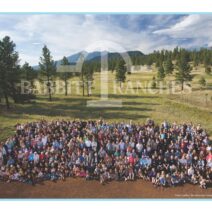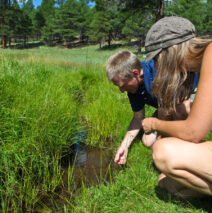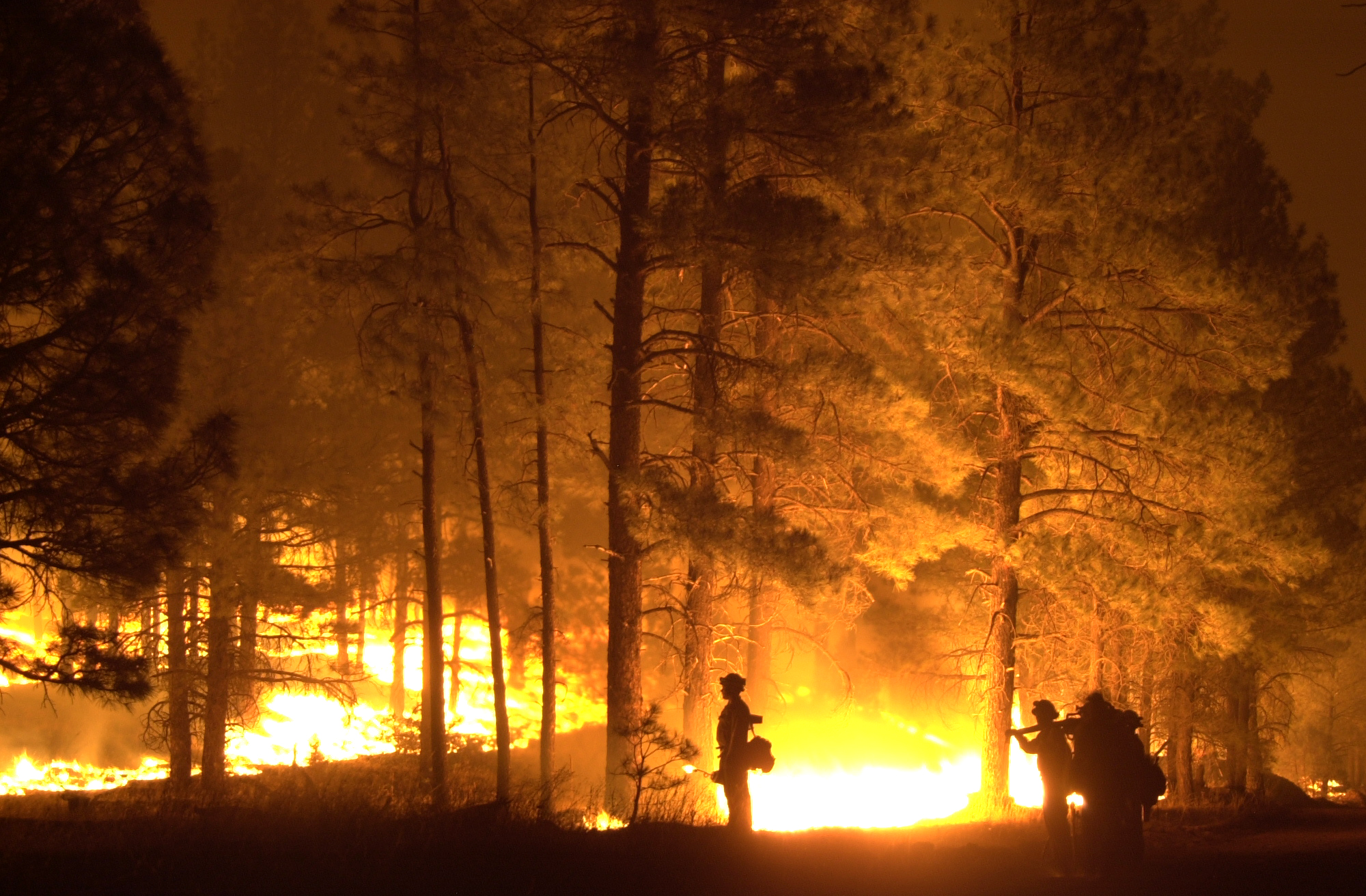SRP and NAU to Study Effects of Forest Restoration
SRP and NAU to Study Effects of Forest Restoration FLAGSTAFF, Ariz. – Scientists say Arizona’s overcrowded forests are affecting the natural processes of a healthy ecosystem. Past studies have shown that much of Arizona’s ponderosa pine forests have hundreds of trees more per acre than existed prior to 1900. This overstocking has had dramatic impacts on the hydrologic cycle, as well as related impacts to range conditions and wildlife habitat. In addition, where fire was once a welcome visitor to the forest in helping to thin trees and recycle nutrients, fire now is prone to explode into a catastrophic stand-replacing wildfire. The effects of climate change are likely only to make matters worse. To find out how the forest ecosystem responds to landscape-scale forest-restoration efforts, the Ecological Restoration Institute (ERI) at Northern Arizona University and Salt River Project (SRP) are teaming up in an unprecedented research project through 2013. Findings from the half-million-dollar study, “Predicting hydrologic and other natural resource responses to restoration treatments and changing climate for the Verde River Watershed,” are expected to help the Forest Service and stakeholders of the Four Forest Restoration Initiative, or 4FRI, make science-based decisions that benefit watersheds in the massive 2.4 million-acre forest-health project across the Mogollon Rim. “As stewards of the Salt, Verde and East Clear Creek water resources, SRP is tremendously interested in how the 4FRI effort will influence the dynamics of the watershed hydrology, water quality, sediment loads and carbon cycle of the forests,” said Charlie Ester, manager of Water Resource Operations for SRP, the largest provider of water and power to the Phoenix metropolitan area. “This is the nation’s largest forest-restoration effort ever attempted, and from a watershed standpoint it will ultimately impact millions of Arizonans. Our hope is that the research with NAU shows that restoration of the forest ecosystem results in a healthy and properly functioning ecosystem that is more resilient than existing conditions.” “The ability of Arizona’s forests to provide high-quality water has been compromised by degraded forest health,” said ERI Executive Director Wally Covington, Ph.D., the principal scientist on the project. “In the last century, Arizona’s ponderosa pine forests have become denser because of fire suppression, grazing and past logging practices. Through this study with SRP, we need to better understand how these denser forests impact sublimation of snowfall. Connecting tree canopies intercept snow where it evaporates before reaching the ground. Anticipating there is less snow accumulation and snow retention, what is the impact on stream-flow runoff and groundwater recharge?” In addition, Covington said excess trees on the landscape are absorbing water that historically would be supporting wetlands. And, overcrowded forests are providing fuel for unnaturally intense wildfires. “Stand-replacing crown fires, like the Wallow Fire, burn up the vegetation and can make the soil hydrophobic, so it doesn’t absorb water for a period of time after the fire,” said ERI Director of Research and Development Dave Huffman, Ph.D., the co-investigator on the study. “As a result, monsoon rains in the high country following these intense wildfires can produce serious erosion, moving tons of soil, downed logs and ash downstream where they clog up lakes and reservoirs.” “There are a number of issues with sediment deposits,” said co-investigator Abe Springer, Ph.D., a hydrogeologist with NAU’s School of Earth Sciences and Environmental Sustainability. “One immediate concern is for the health of aquatic organisms when there’s a change in water quality. Another is the sediment build-up in reservoirs. That can impact the water supply by decreasing the ability of the reservoir to store water.” The NAU-SRP study will involve computer modeling to understand what happens to...
Read MoreAn Era of Mega Fires
Helplessness. That was the feeling firefighters like Paul Summerfelt remember at the start of the record-setting fire. "You could just watch the cloud of smoke on the horizon," Summerfelt said. "You knew it was coming and you knew it was bigger than you were going to be able to deal with." Apache-Sitgreaves National Forests Supervisor Jim Zornes remembers seeing smoke from 30 miles away. "We knew we had a tiger by the tail but we didn't know how big it was," Zornes said. "I just almost fainted when we realized the potential for the fire. I thought, 'surely not!'" Both men are talking about two different half-million acre fires that have occurred in Arizona's White Mountains during the last decade. Summerfelt is recalling the 2002 Rodeo-Chediski Fire and Zornes, the 2011 Wallow Fire. Forest ecologist and Regents' Professor Wally Covington, Ph.D., says we've entered an era of mega fires. "Mega fires are huge, landscape-scale fires in excess of 100-thousand acres," said Covington, executive director of the Ecological Restoration Institute (ERI) at Northern Arizona University. "We're seeing this throughout the West, but Arizona is on the leading edge." Covington says mega fires are symptoms of an unhealthy forest caused by a century of actions -- mostly fire suppression, and overgrazing during the late 1800s -- that have changed the structure and function of ponderosa pine and dry mixed conifer forests. "We need to stop being surprised by the types of fires we're having," said Summerfelt, wildland fire management officer for the city of Flagstaff. "My first fire was on the North Kaibab and it was considered huge. It was 20 acres. A 20-acre fire now means nothing. So in those three-and-a-half decades in my career, I've been able to watch fire change in size and intensity to levels today that even a decade ago would have been unthinkable. And we're not done breaking records." Covington says Arizona is set up for three more enormous crown fires across the Mogollon Rim that burn through the tops of old growth trees and can ignite spot fires as far as 3 miles ahead of the blaze. "There's the Payson to Winslow corridor, the Sedona to Flagstaff corridor and the Prescott corridor. If we don't get out in front of these and do restoration treatments, it's just going to be a matter of time before we have three more major landscapes burn up." As we approach the 10th anniversary of the Rodeo-Chediski Fire, scientists, firefighters and natural resource managers are examining today's forest conditions and reviewing lessons learned from the state's two largest fires. To compare, both fires were started by people on warm, dry, windy days. "With the Wallow Fire, we knew we were in extreme conditions. We had fuel everywhere and our probability of ignition for any fire that hit the ground was 100 percent. With 62 mph wind gusts, it was blowing so hard it was tough to walk," said Zornes. Former Forest Service ranger and firefighter Jim Paxon, now Arizona Game and Fish Department spokesperson, describes the 468,000-acre Rodeo-Chediski Fire as a plume-dominated fire. "It was pretty much fuels related, fed by the millions of excess trees in our overcrowded forests. It had extremely high energy. When I started fighting fire in the late'60s we didn't have these big columns of plumes that would build up, collapse in an explosion on the ground and create hurricane winds. This didn't happen until the '90s." As a result, 49 percent of the area in the Rodeo-Chediski Fire was considered severely burned. For the 538,000-acre Wallow Fire, that figure is 28 percent. "It...
Read More





